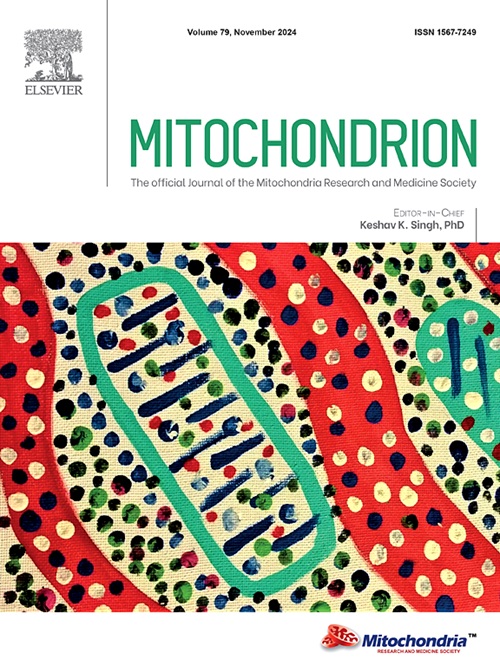Loss of PGC-1α causes depot-specific alterations in mitochondrial capacity, ROS handling and adaptive responses to metabolic stress in white adipose tissue
IF 4.5
3区 生物学
Q2 CELL BIOLOGY
引用次数: 0
Abstract
White adipose tissue (WAT) delivers lipid-fueled metabolic support to systemic energy expenditure through control of lipolytic and re-esterifying regulatory pathways, facilitated by mitochondrial bioenergetic support. Mitochondria are important sources of reactive oxygen species (ROS) and oxidative damage may potentially derail adipocyte function when mitochondrial homeostasis is challenged by overproduction of ROS. Peroxisome proliferator-activated receptor-gamma coactivator (PGC)-1α is a transcriptional co-activator that in skeletal muscle plays a central role in mitochondrial biogenesis and function but whether PGC-1α is equally important for mitochondrial function and adaptations in white adipose tissue remains to be fully resolved. The aim of the present study was to characterize the necessity of adipocyte PGC-1α for adaptive regulation of mitochondrial function in distinct white adipose depots. PGC-1α adipose tissue-specific knockout (ATKO) and floxed littermate control mice (CTRL) were subjected to either 24 h of fasting or 48 h of cold exposure. Bioenergetics, ROS handling, basal and adaptive protein responses, markers of protein damage as well as lipid cycling capacity and regulation were characterized in distinct WAT depots.
ATKO mice demonstrated impairments in respiration as well as reduced OXPHOS protein content in fed and fasted conditions. Increased ROS emission in tandem with diminished mitochondrial antioxidant defense capacity resulted in increased protein oxidation in ATKO WAT. Adipose tissue PGC-1α knockout also led to changes in regulation of lipolysis and potentially triglyceride reesterification in WAT. In conclusion, PGC-1α regulates adipose tissue mitochondrial respiration and ROS balance as well as lipid cycling during metabolic challenges in a depot specific manner.
PGC-1α的缺失导致白色脂肪组织线粒体能力、ROS处理和代谢应激适应性反应的特异性改变
白色脂肪组织(WAT)通过控制脂肪分解和再酯化调节途径,在线粒体生物能量支持的促进下,为全身能量消耗提供脂质燃料代谢支持。线粒体是活性氧(ROS)的重要来源,当线粒体内稳态受到活性氧过量产生的挑战时,氧化损伤可能会破坏脂肪细胞的功能。过氧化物酶体增殖体激活受体- γ共激活因子(PGC)-1α是一种转录共激活因子,在骨骼肌中对线粒体的生物发生和功能起着核心作用,但PGC-1α是否对白色脂肪组织的线粒体功能和适应性同样重要仍有待完全解决。本研究的目的是表征脂肪细胞PGC-1α对不同白色脂肪库线粒体功能适应性调节的必要性。PGC-1α脂肪组织特异性敲除小鼠(ATKO)和固定窝偶对照小鼠(CTRL)进行24小时禁食或48小时冷暴露。研究了不同WAT库的生物能量学、活性氧处理、基础和适应性蛋白质反应、蛋白质损伤标志物以及脂质循环能力和调节。在喂食和禁食条件下,ATKO小鼠表现出呼吸损伤以及OXPHOS蛋白含量降低。随着线粒体抗氧化防御能力的减弱,ROS释放增加导致ATKO WAT中蛋白质氧化增加。脂肪组织PGC-1α敲除也导致WAT中脂肪分解和甘油三酯再酯化调节的变化。综上所述,PGC-1α以一种特定的方式调节脂肪组织线粒体呼吸和ROS平衡以及代谢挑战过程中的脂质循环。
本文章由计算机程序翻译,如有差异,请以英文原文为准。
求助全文
约1分钟内获得全文
求助全文
来源期刊

Mitochondrion
生物-细胞生物学
CiteScore
9.40
自引率
4.50%
发文量
86
审稿时长
13.6 weeks
期刊介绍:
Mitochondrion is a definitive, high profile, peer-reviewed international research journal. The scope of Mitochondrion is broad, reporting on basic science of mitochondria from all organisms and from basic research to pathology and clinical aspects of mitochondrial diseases. The journal welcomes original contributions from investigators working in diverse sub-disciplines such as evolution, biophysics, biochemistry, molecular and cell biology, genetics, pharmacology, toxicology, forensic science, programmed cell death, aging, cancer and clinical features of mitochondrial diseases.
 求助内容:
求助内容: 应助结果提醒方式:
应助结果提醒方式:


